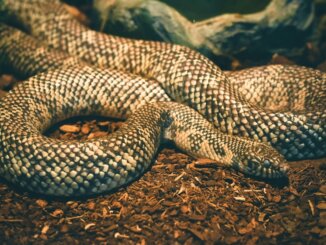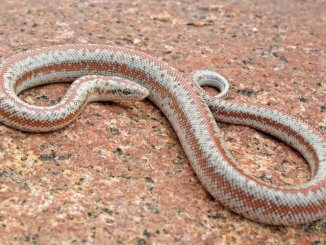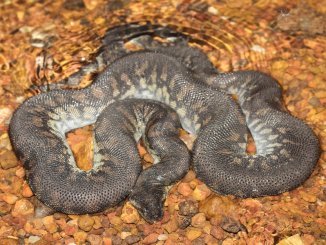The glossy snake is a member of the Colubridae family and looks similar to a gopher snake. Glossy snakes have bleached-out colors over shimmering scales that vary in color and pattern. The Arizona elegans is native to arid regions in the Southwestern United States.
Caring for glossy snakes is easy because they aren’t fussy eaters and remain calm as popular reptilian pets. The habitat requirements for these glossy serpents are easy for inexperienced reptile keepers, and the snakes live and breed well in captivity.
Glossy Snake Overview
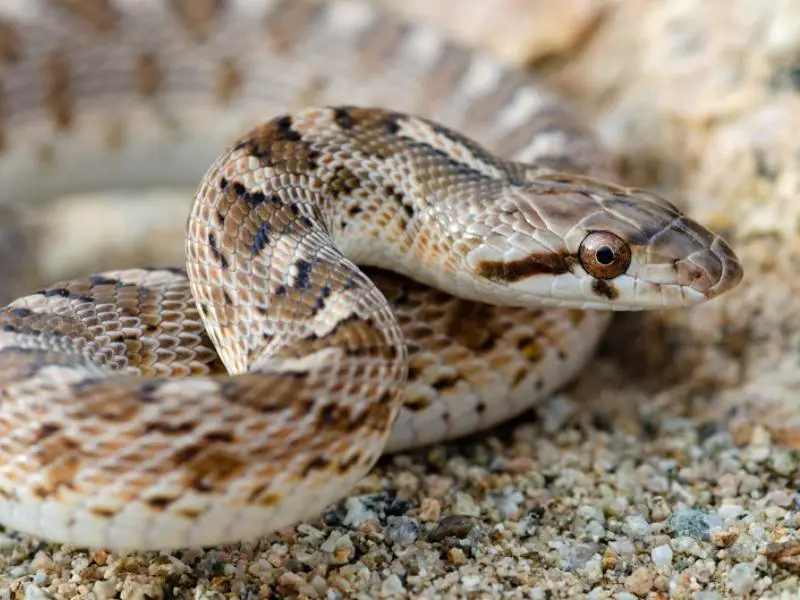
| Common name | Glossy snake, Western glossy snake, faded snake, Arizona glossy snake |
| Scientific name | Arizona elegans |
| Natural habitat | Semi-arid grasslands in Southwestern United States |
| Adult size | 26–70 inches |
| Average lifespan | 10–20 years |
| Diet | Frozen adult mice and lizards |
| Housing | Tank: 30 inches wide, 12 inches deep, 12 inches high Temperature: 75–80°F and a 90°F hot spot Humidity: 50% |
| Experience level | Beginner |
Origin
The glossy snake (Arizona elegans) is common in the southwestern regions of the United States. The snakes are versatile, thriving in semi-arid, grassland, desert, sagebrush, and chaparral regions in western California, the eastern states up to Kansas, Texas, and northern Mexico. The snakes are also commonly found in areas with hardwood, pine juniper, and rocky washes.
The glossy serpent is a nocturnal and crepuscular carnivore, meaning it actively awaits prey at night and during twilight or dusk hours. The Arizona glossy species have numerous subspecies, including:
- California glossy snake (Arizona elegans occindentalis)
- Painted desert glossy snake (Arizona elegans philippi)
- Texas glossy snake (Arizona elegans arenicola)
- Chihuahua glossy snake (Arizona elegans expolita)
- Western Mojave glossy snake (Arizona elegans candida)
Appearance and Behavior
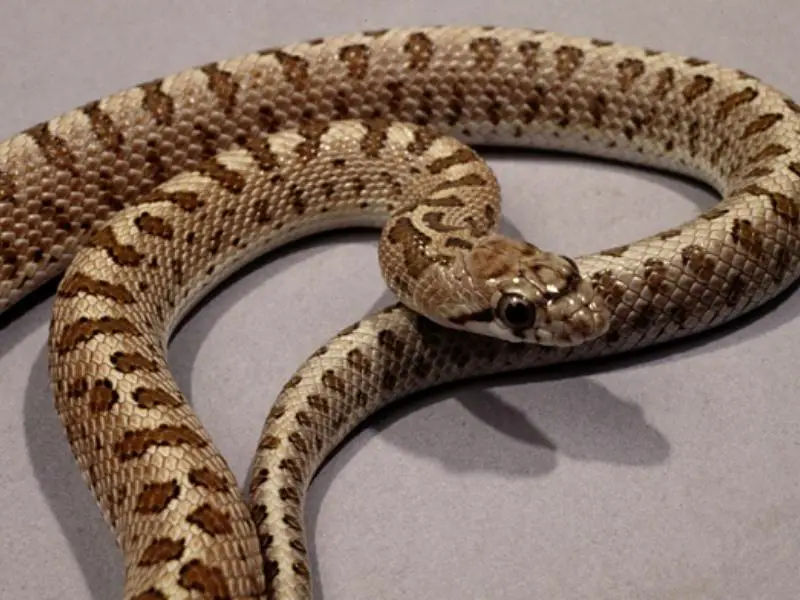
Arizona glossy snakes are medium-sized colubrids with gray, white, tan, brown, or yellowish-brown scales that shimmer. The scales are smooth, and the snake has white or cream-colored unmarked ventral scales on its underbelly.
An Arizona glossy snake has a pointed, narrow head, sunken inferior mandible, and egg-shaped pupils. These snakes have faded patterns with slightly darker spots from the top of their heads to their tails. The pattern colors vary depending on the color of the soil in the snake’s native habitat.
Male glossy snakes have more prominent colors and patterns than females. The female serpent is long with a broad tail, and the male snake is short with a narrow tail. Juvenile snakes are darker than adults and fade as they mature.
Size and Lifespan
An adult glossy snake’s length ranges between 26 and 70 inches. Captive adults commonly range from 30 to 50 inches long, and the snakes live 10 to 20 years in captivity.
Temperament
Glossy snakes are calm, nonvenomous, and only bite if provoked. This behavior makes the snakes ideal for handling. Diurnal, or daytime, activity is rare among glossy snakes. These snakes are most active at night and dusk when they wait for prey.
Winter inactivity or hibernation is common and glossy snakes are typically active from May to July. The snake isn’t actively social until breeding season. These snakes aren’t known to be territorial, and they spend most of the day and winter in burrows and rock outcrops.
Housing Glossy Snakes
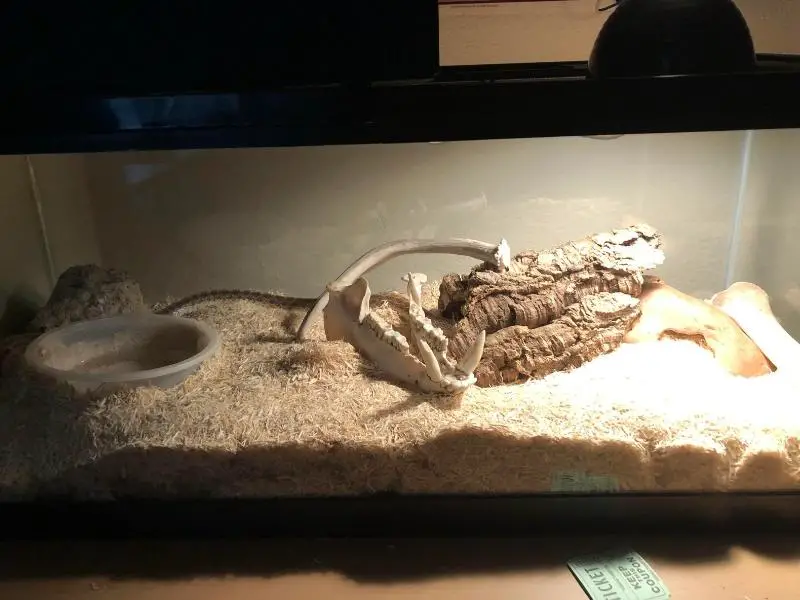
Glossy snakes live in semi-arid grasslands, rocky areas, shrub-filled areas, and granular wastelands with plenty of open space and burrowing regions. The snake requires a vivarium with sufficient space, substrate, lighting, heating, and decorations that replicate its natural habitat.
Enclosure size
Adult Arizona glossy snakes thrive in exclosures that measure 30 inches wide, 12 inches deep, and 12 inches high. Add a tight cover or secure screen top to keep the snake safe inside the tank. Buy a higher tank, measuring 20 inches tall, if the snake reaches over 50 inches in length.
Lighting
Arizona glossy snakes require a basking light placed over a flat rock or twig, where the snake can lounge in the light for an hour daily. Alternatively, use an ultraviolet beam light for daily heat exposure in the basking area. The snake won’t bask during hibernation periods.
Temperature and Humidity
The glossy snake’s vivarium needs two temperature spaces. Turn 65% of the vivarium into a cool spot and use thermometers to maintain a temperature of 75 to 80°F. Create a hot area of 90°F, with an under-tank reptile heating pad, in the other 35% of the tank. Don’t place the heating pad under the entire tank.
The glossy snake is happy with humidity levels from 0% to 50% and regulates its body temperature by burrowing and moving between cooler and hotter spots. Use a hygrometer to measure the humidity inside the tank.
Humidity is easily controlled by placing a small bowl of water on the cool side of the tank. The bowl should only be large enough for the glossy serpent to drink from.
Maintaining the correct humidity and temperature in the vivarium ensures the snake sheds properly. Juvenile glossy reptiles shed every month, while adult snakes shed every 60 days. Should a snake take too long to shed or appear to require assistance, increase the humidity with a second water bowl, in the cooler corner of the tank, or add moistened paper towels to the tank.
Substrate and Decoration
Arizona glossy snakes use burrows, fissures, and mouse tunnels as daytime refuges, and a loose substrate is essential for this purpose. Mimic the snake’s native habitat by lining the vivarium with a mixture of soft, loose compost, gravel, and copper wood.
The glossy serpent requires several hiding spots. Include one hiding spot on each end of the tank. Use materials like carved logs, flat rocks in the basking area, and half-buried garden pots to create these hiding areas. The snake will burrow holes into the substrate beneath the hideouts.
Bamboo, orchid, peperomia, spider plants, pothos, violets, ponytails, and jade plants also make great vegetation decorations that the snake can burrow under and use as a hiding spot.
Cleaning
Cleaning a glossy snake’s tank is recommended every two months during active seasons and once during hibernation.
Follow the steps below to clean a vivarium:
Materials:
- A Sterilite container with holes poked in it
- Paper towels
- Fresh substrate mix
- Log hides
- Spray disinfectant
- Bleach
- Regular dish soap (optional)
Method:
- Remove the snake from the tank when it has no bulges from eating. Place the snake safely in the Sterilite container
- Switch off all electronics, including the heating pad. Allow the tank glass to cool to room temperature while taking out the decorations
- Soak the decorations and water bowl in one part bleach to four parts water for an hour. Don’t soak logs and twigs. Discard the old logs
- Remove the substrate before spraying the entire tank with the disinfectant cleaner. Be sure to spray the crevices
- Dry the tank with paper towels, and allow it to air dry for 30 minutes
- Remove the decorations and water bowl from the bleach water, and rinse them well under warm running water
- Add new substrate to the tank, replace the heating pad under one corner, and put the decorations back inside. Make sure to use new logs and twigs
- Fill the small water bowl with fresh water. Switch the heating pad and hygrometer on before putting the snake back in the tank
Only use reptile-friendly disinfectants inside the tank. Bleach can be replaced with regular dish soap during active months. Bleach soaks are best for hibernation or extended cleaning periods.
Glossy Snake Care
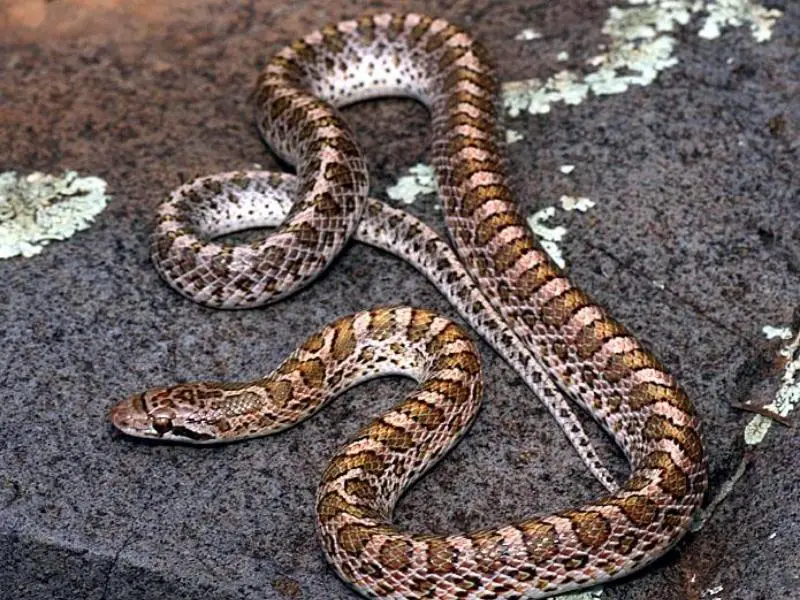
Glossy snakes are constrictors, but they prefer dead prey. These snakes aren’t fussy eaters, and they can be handled between feedings when their bellies aren’t full.
Food and Water
Glossy serpents are carnivorous reptiles that require a steady diet of dead prey, which can be easily obtained from exotic pet stores. Rodents come frozen in various sizes and should be thawed before being fed to the snake. Start with lifeless rodents that are the same diameter as the snake’s core.
Feed a glossy snake one dead rodent at a time, and offer another one until the snake no longer takes the food. Large glossy snakes eat up to 12 rodents in one feeding. If the snake doesn’t eat lifeless food, attempt feeding the snake live food.
Other food sources popular with these snakes include lizards, muskrats, and small amphibians. Juvenile glossy snakes eat insects like crickets and mealworms and will begin eating pinky mice as soon as they can fit the mice in their mouths.
These snakes are carnivorous and shouldn’t be fed vegetation. Juvenile snakes eat twice per week, while adults eat once a week or every other week. Be sure to supply the glossy snake with fresh water twice a week.
Handling
Before picking up the glossy snake, make sure there aren’t any bulges in the snake’s core. Bulges signal that the snake hasn’t finished digesting its food.
Approach the Arizona glossy snake gently, then wrap both hands under its belly to support its weight. Keep one hand under the snake’s body, and move another hand under the head to lift the snake.
Situations that stress the glossy snake include incorrect handling, placing its tank in direct sunlight, excessive noise from children and other animals, and the sight of predators.
Don’t handle this species until it has consumed at least four feedings in its new home, and don’t handle glossy snakes outdoors, as these snakes are prey for aggressive snakes and owls.
Common Health Issues
The Arizona elegans snake doesn’t suffer from many diseases. However, stress and pests, like bed insects, can affect the health of these snakes.
Stress
Glossy snakes show signs of stress by breathing heavily for prolonged periods, losing their appetites, and hiding during active times. These snakes also defecate or urinate on the handler, jerk when touched, and rattle their tails when stressed.
Double-check the snake’s tank requirements to ensure the snake’s temperature, humidity, hiding, and substrate needs are met. Ensure the tank is away from windows so the snake can’t see predators.
Bed Pests
Glossy snakes can be affected by numerous types of bed pests that hide in the substrate. The pest bites are painful and cause foul-smelling skin sheds. Affected snakes appear stressed, have behavior changes, and may have bite marks on their scales.
If you suspect the snake’s tank has a bed pest infestation, take a substrate sample to the local veterinarian to determine the pest species. The veterinarian will prescribe lotions for the snake to soothe itching and pain. Completely disinfect the tank and replace the substrate if an infestation is discovered.
Hibernation
The Arizona glossy snake hibernates in its native habitat and should continue regular hibernation in captivity.
Beginning at the end of October, use daily, lukewarm, 1-inch deep baths to promote the hibernation process. Gradually reduce the water temperature daily, but do not use water under 80°F.
Turn the hot spot’s temperature down by 1°F each day until the temperature is 80°F, or the temperature matches the cooler side of the tank. The snake will burrow into a hole to begin hibernation. Freshwater should be placed outside the hole weekly until the snake wakes up in early spring.
Breeding
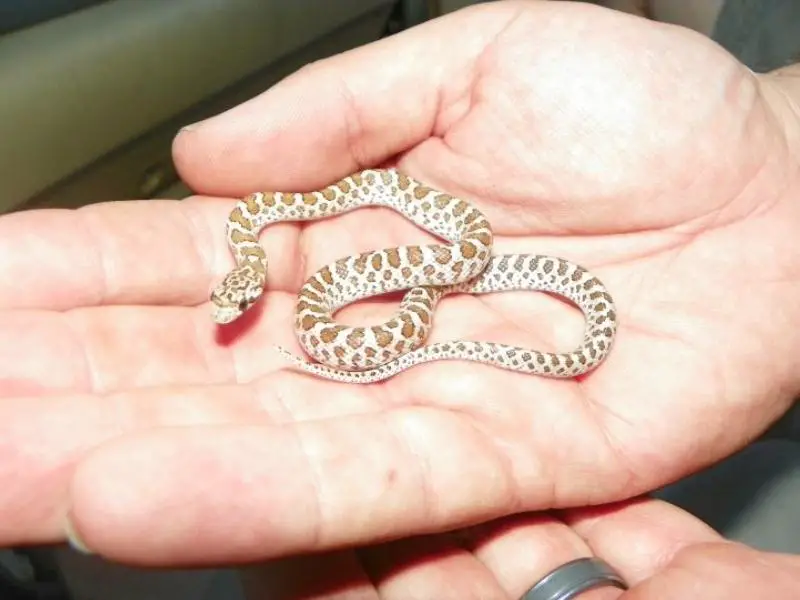
Healthy glossy snakes breed well under the right conditions after they’ve hibernated.
Place the female inside the same tank as the male. The female will release pheromones to attract the male. When the match is a success, the female will lay, relaxed, near the male. Remove the female from the tank in the morning and replace her in the male’s tank at night until the female no longer seems interested.
Successful breeding is seen when the two snakes lock or look intertwined. Locking can last from four hours to two days.
The female glossy serpent will carry the eggs for up to 45 days before burrowing them under the substrate. Incubation lasts another 72 days before the clutch of 3–23 hatchlings appears. The eggs should hatch between the end of August and early September.
Unsuccessful breeding happens when the female is interested, but the two snakes don’t lock after seven days of sharing a tank. Keep the snakes apart for four days before putting them in the same tank for another seven days.
Choosing and Buying a Glossy Snake
Glossy snakes aren’t available in pet stores, and the United States has different permit requirements, per state, regarding reptile trading. For example, Texas requires nonindigenous snake permits for buying, breeding, and selling snakes. It’s illegal to hunt or collect native reptiles in California.
Glossy snakes should be bought from a reputable breeder who has the required permits, and who can advise you on the local laws.
The prices for these snakes start at $40 for a juvenile. Some reputable breeders include:
Juvenile glossy snakes bought from reputable breeders should have dark markings and no bites, nicks, or scuffs on their scales. Look for signs of poor health including discharge from the snake’s nose and mouth or a lack of glossy coloring on the scales.

